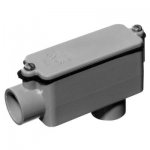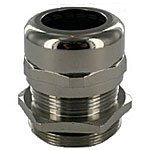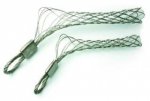Right now I just have an opening on the top of the equipment. The GC who installs the equipment will be required to supply the strain relief for the power connection. If cable (SOOW for example) is selected, then it is easy enough to spec a chord grip and strain relief using NEC 400.5A
Where it gets confusing for me, is what if the customer decides to make it a permanently connected installation and not chord connected. Then, they would have the option to run individual conductors to the equipment. Here is where the tables in NEC 310.15(B)15 would come into play. The customer would likely run conduit to the opening (located 7 feet off the floor) to connect to the equipment. Since the equipment is 7 feet off of the floor, I would like to provide strain relief to minimize the force on the distribution blocks located on the sub panel.
The L shaped fitting normally would connect to a NPT threaded fitting on the equipment, and guide the wires downward. But being this high off the ground, I would still have strain on my wires and would need to provide some sort of strain relief.
So ideally, I would have a fitting that would also have an NPT threading on it so that conduit could attach. Does this exist, or would I have to provide the strain relief separate from the conduit?




